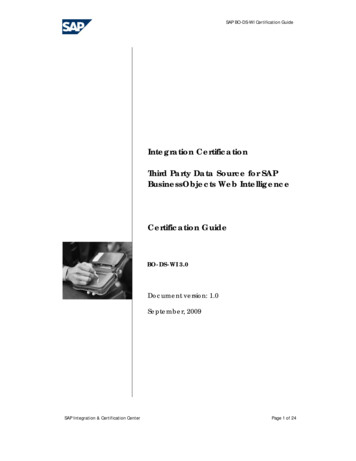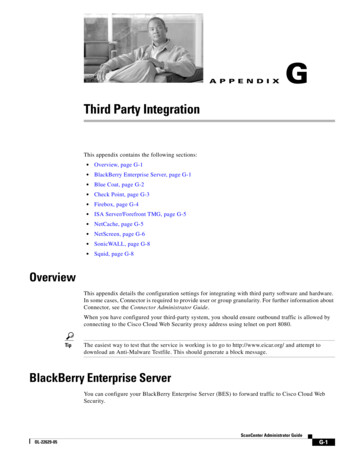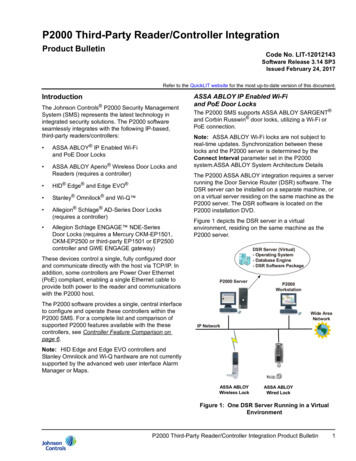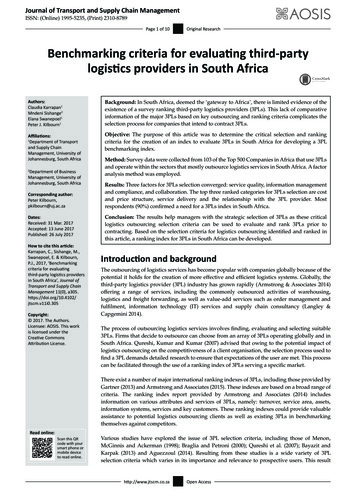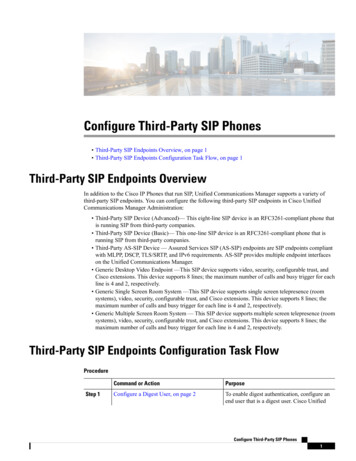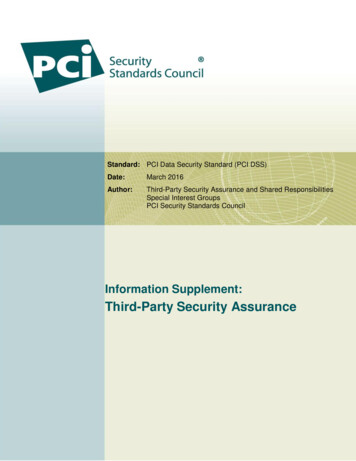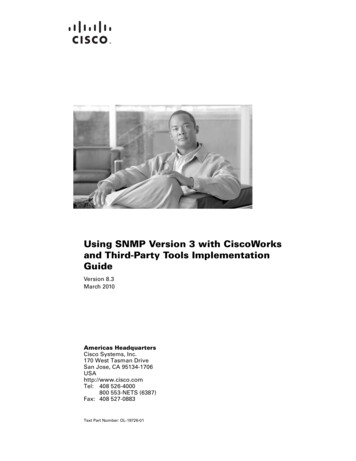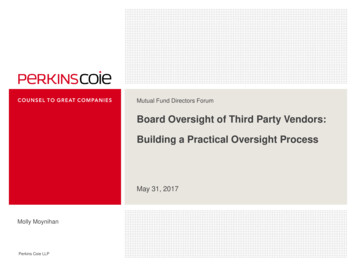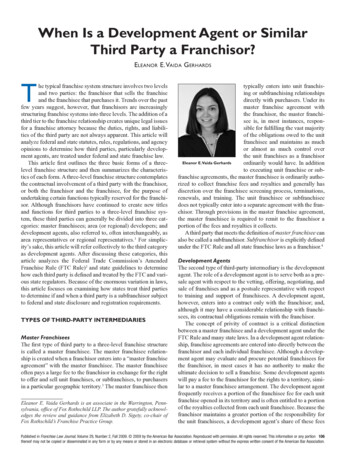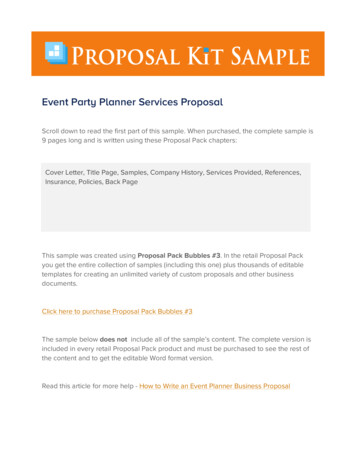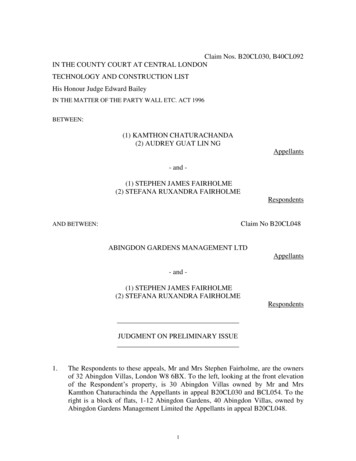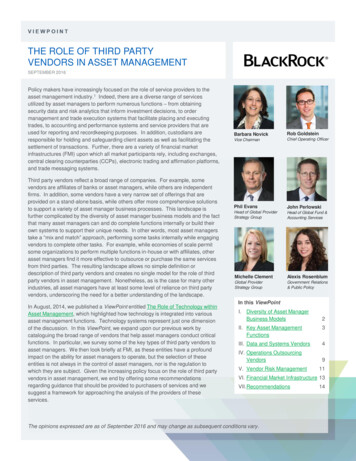
Transcription
THE ROLE OF THIRD PARTYVENDORS IN ASSET MANAGEMENTSEPTEMBER 2016Policy makers have increasingly focused on the role of service providers to theasset management industry.1 Indeed, there are a diverse range of servicesutilized by asset managers to perform numerous functions – from obtainingsecurity data and risk analytics that inform investment decisions, to ordermanagement and trade execution systems that facilitate placing and executingtrades, to accounting and performance systems and service providers that areused for reporting and recordkeeping purposes. In addition, custodians areresponsible for holding and safeguarding client assets as well as facilitating thesettlement of transactions. Further, there are a variety of financial marketinfrastructures (FMI) upon which all market participants rely, including exchanges,central clearing counterparties (CCPs), electronic trading and affirmation platforms,and trade messaging systems.Third party vendors reflect a broad range of companies. For example, somevendors are affiliates of banks or asset managers, while others are independentfirms. In addition, some vendors have a very narrow set of offerings that areprovided on a stand-alone basis, while others offer more comprehensive solutionsto support a variety of asset manager business processes. This landscape isfurther complicated by the diversity of asset manager business models and the factthat many asset managers can and do complete functions internally or build theirown systems to support their unique needs. In other words, most asset managerstake a “mix and match” approach, performing some tasks internally while engagingvendors to complete other tasks. For example, while economies of scale permitsome organizations to perform multiple functions in-house or with affiliates, otherasset managers find it more effective to outsource or purchase the same servicesfrom third parties. The resulting landscape allows no simple definition ordescription of third party vendors and creates no single model for the role of thirdparty vendors in asset management. Nonetheless, as is the case for many otherindustries, all asset managers have at least some level of reliance on third partyvendors, underscoring the need for a better understanding of the landscape.In August, 2014, we published a ViewPoint entitled The Role of Technology withinAsset Management, which highlighted how technology is integrated into variousasset management functions. Technology systems represent just one dimensionof the discussion. In this ViewPoint, we expand upon our previous work bycataloguing the broad range of vendors that help asset managers conduct criticalfunctions. In particular, we survey some of the key types of third party vendors toasset managers. We then look briefly at FMI, as these entities have a profoundimpact on the ability for asset managers to operate, but the selection of theseentities is not always in the control of asset managers, nor is the regulation towhich they are subject. Given the increasing policy focus on the role of third partyvendors in asset management, we end by offering some recommendationsregarding guidance that should be provided to purchasers of services and wesuggest a framework for approaching the analysis of the providers of theseservices.Barbara NovickRob GoldsteinVice ChairmanChief Operating OfficerPhil EvansJohn PerlowskiHead of Global ProviderStrategy GroupHead of Global Fund &Accounting ServicesMichelle ClementAlexis RosenblumGlobal ProviderStrategy GroupGovernment Relations& Public PolicyIn this ViewPointI. Diversity of Asset ManagerBusiness Models2II. Key Asset ManagementFunctions3III. Data and Systems Vendors4IV. Operations OutsourcingVendors9V. Vendor Risk Management11VI. Financial Market Infrastructure 13VII.RecommendationsThe opinions expressed are as of September 2016 and may change as subsequent conditions vary.14
The purpose of this paper is to provide an overview of keyvendors within the asset management landscape; however,this paper is by no means comprehensive, as there isconsiderable variation around the role of third party vendorsand there are hundreds of different vendors offering a widerange of data, systems, and outsourcing services.Nonetheless, we hope the paper will be helpful in beginning adialogue on this important subject. Given the breadth of thistopic, there is clearly a need for further analysis by policymakers before drawing conclusions about potential risks thatthe use of third party vendors by asset managers (or thevendors themselves) may present.Diversity of Asset Manager Business ModelsThe asset management industry serves a broad range ofclients from defined benefit and defined contribution pensionplans to insurers, sovereign wealth funds and other officialinstitutions, family offices, foundations, endowments,individual clients, and more. Each of these clients has theirown unique investment objectives and constraints. Thediversity of client needs results in a wide variety of firmstructures and business models across the industry, rangingfrom investment boutiques that focus on a single product orclientele to larger institutions that offer multiple services inaddition to asset management.The organizational structure of asset managers also varieswidely. Some asset managers are operated by publiclytraded companies that are subject to a variety of financialdisclosure standards.3 Other asset managers are privatelyheld entities and, therefore, are not subject to public companyreporting standards. Another means of distinguishing assetmanagers is whether or not they are affiliated with other typesof businesses due to ownership by a common parentcompany.4 Affiliations with other types of financial servicesproviders generally affords significant opportunities to findsynergies and cost efficiencies in terms of being able toprovide a more comprehensive suite or bundle of services toa given client base. Banks represent the best examples ofthis model, as most banks have affiliates that providecustodial services, transfer agent services, assetmanagement, agent lending capabilities, and fundadministration.Another key area of diversity among asset managers is theinvestment strategies and products offered. Whereas manyasset managers specialize in a single asset class orinvestment strategy, many others offer a variety of investmentstrategies managed by different portfolio management teams.Further, asset managers can focus on a specific investmentstyle (e.g., passive index tracking versus activemanagement), while others offer multiple investment styles.KEY OBSERVATIONSAll asset managers utilize multiple third party vendors. There are numerous vendors providing a wide range of services to asset managers. The range of services and the number of vendors reflect the growing diversity of the global market ecosystem andconcomitantly the asset management industry. Asset managers need a vendor management program and a business continuity management program that factors inservices provided by third parties. Where they have not already done so, regulators should provide guidance for conducting due diligence on vendors,including reviewing business continuity and technology disaster recovery plans, as well as cybersecurity standards.As providers of services, vendors should include business continuity management, technology disaster recoveryplanning, and cybersecurity as critical components of their business models and operations. Any new rules established for vendors of data, systems, or outsourcing services should be applied to all vendors withsimilar offerings, regardless of their organizational structure or affiliation with another organization.Custodian banks play a central role in safeguarding client assets and often provide a variety of additional services. Additional services provided by custodians can include cash management, foreign exchange and currency hedging,securities lending agent services, fund accounting and administration, among others. The regulation of custodians has been updated post-crisis in several jurisdictions.2Special attention should be given to shared financial market infrastructure, which are critical to the properfunctioning of capital markets, including asset management. Exchanges and CCPs are central resources that are relied on by virtually all participants in the market ecosystem, not justasset managers. The SWIFT messaging network is the primary communications network used by banks, insurers, asset managers, andasset owners that manage their assets directly (e.g., sovereign wealth funds, pensions, insurers, etc.). Depositories facilitate the movement of securities, foreign exchange, and other positions from one counterparty to another.[2]
In addition, there are many asset managers that specialize inalternative asset classes including real estate, private equity,venture capital, and hedge funds.Product structure and client base are additional differentiatorsis assessing the business models of asset managers. Forexample many managers offer commingled investmentvehicles (CIVs) such as registered mutual funds and privatefunds. These products have a range of administrative,operational, and regulatory requirements, which can differfrom one jurisdiction to another. Further, the operational andregulatory requirements of separate accounts differsomewhat from those of funds. As such, the productstructures offered and jurisdictions in which the manageroperates can shape how that manager chooses to structureits business, as well as its need to utilize third party data,systems, and the degree to which operational functions areoutsourced to third party vendors.Key Asset Management FunctionsIn order to understand the role that third party vendors play inthe asset management ecosystem, it is helpful to first thinkabout the main functions that an asset manager must carryout on a daily basis. We will categorize these functions undertwo broad umbrellas: (i) investment decision-making andexecution, and (ii) operational functions, as shown in Exhibit 1.Investment decision-making and execution and operationalprocesses interact in many ways in the course of managingassets on behalf of clients and how these processes arecarried out may differ significantly from one asset manager toanother, depending on the manager’s organizationalstructure, product set, client base, and the unique choicesthat the asset manager makes in the course of running itsbusiness. Importantly, there are a variety of data andsystems that underlie both investment decision-making andexecution, as well as operational functions.Investment Decision-Making & ExecutionInvestment processes are the core functions that come tomind when considering the work of asset managers. Eachasset manager has the choice of how to set up its investmentdecision-making and execution function(s). For example,some asset managers have multiple portfolio teams thatmake investment decisions for specific portfolios independentfrom one another, while other asset managers establish a“house view” that is implemented across all portfolios.Likewise, some asset managers specialize in one asset classor market, while others offer investment products in multipleasset classes and markets. Nonetheless, while the exactsetup and structure of investment decision-making andexecution functions may differ, all asset managers generallyExhibit 1: ASSET MANAGER INVESTMENT PROCESSFor illustrative purposes only. Not meant to be comprehensive.Operational functions can be performed in-house or outsourced to affiliates or to third party vendors.There are numerous interactions between investment decisions & execution and operational functions.[3]
conduct elements of portfolio management, riskmanagement, and trading when managing money on behalfof their clients. Likewise, asset owners who manage theirassets in-house also conduct many of these activities.Portfolio managers make decisions on behalf of clients inorder to meet their clients’ objectives within the agreedportfolio guidelines. Portfolio managers use data as well asrisk models and analytics to make investment decisions.Active managers may base their decisions on research theyconduct about individual securities and markets, as well astheir clients’ guidelines and expectations. While many assetmanagers develop risk models internally, it is also commonfor asset managers to purchase risk models and analyticsfrom third party vendors to supplement their internalanalyses. Market indices also play an important role inportfolio management as many portfolios are managedrelative to a benchmark. In the case of passive investing, forexample, portfolio managers seek to track the compositionand performance of the index.In addition to portfolio management, many asset managershave a risk management function that is independent fromportfolio management. Risk managers work closely withportfolio managers to ensure that client portfolios are beingmanaged in accordance with client guidelines and riskparameters. They perform portfolio risk analysis to ensurethat the risks being taken are deliberate and understood bythe portfolio manager. Similar to portfolio managers, riskmanagers need security and pricing data, as well as riskmodels and analytics to perform their duties.Finally, asset managers place trades as agents on behalf ofclients. Trading requires the generation of orders and theexecution of trades with the market. While trading can beconducted via phone directly with broker-dealers in manymarkets, there are systems that streamline the tradingworkflow and facilitate communication with the requisiteparties. In addition, financial market infrastructure (e.g.,exchanges, electronic trading venues, and Society forWorldwide Interbank Financial Telecommunication (SWIFT))are integral to an asset manager’s ability to place andcommunicate trades on behalf of their clients. Traders alsoutilize pricing and security data in a variety of ways.Operational FunctionsThe business of asset management extends significantlybeyond making investment decisions and trade execution.Transactions need to be settled, cash needs to be trackedand invested, and various systems need to be regularlyreconciled to ensure the books and records of the portfolioare in sync with any other systems relying on this data.Funds such as mutual funds, collective investment funds, andprivate funds, involve additional administrative requirementsfrom fund accounting to detailed disclosure documents andregulatory reporting. For example, many of these productsrequire a transfer agent to track shareholder ownership bymaintaining the official shareholder registry. Further, likeinvestment decision-making and execution, operationalfunctions are powered by a tremendous amount of data andsystems. In addition, given the number of resource-intensiveoperational and administrative requirements associated withmanaging money, asset managers have the ability tooutsource some or all operational functions to a number ofdifferent vendors.In the following sections, we review examples of vendors thatprovide a variety of products and services to the assetmanagement industry.Data and Systems VendorsData is fundamental to everything that asset managers do,from helping to inform key investment functions like portfoliomanagement, risk management, and trading to providing thebackbone for key operational functions like accounting andpricing of securities and fund net asset values (NAVs),recordkeeping, portfolio compliance and more. To this end,asset managers require a variety of data on a daily or intraday basis and need to purchase data from multiple vendors.Further, asset managers need systems to manage all of therequisite data and information.Historically, asset managers typically relied on internallydeveloped technology solutions in conjunction with manuallymaintained spreadsheets. As the landscape has evolved,however, the effort required to load, cleanse, and processdata has increased significantly leading asset managers tolook for more sophisticated solutions. In particular, manyasset managers have decided to purchase systems from thirdparty vendors to help them perform a variety of tasks relatedto investment-decision making and execution as well asoperational functions. That said, many other asset managerscontinue to use internally developed systems, which theycustomize to meet their individual needs. In these instances,the asset manager must make a greater commitment tobuilding and maintaining technology resources andcapabilities in-house. In many cases, asset managers use acombination of third party and internally built systems.Given the demand for data and systems by asset managers,there are numerous competing vendors offering a variety ofsolutions. In this section, we review some of the mainvendors in key areas. For data providers, we look at securitydata and pricing vendors as well as index providers. Withrespect to systems, we review vendors of risk models andanalytics, order management systems (OMS) and tradeexecution systems, as well as accounting systems. As shownin Exhibit 2, in many cases, the same vendors provide bothdata and systems.[4]
Security & Pricing Data VendorsAsset managers require a variety of data on the universe ofsecurities within their portfolios and benchmarks. Thisinformation informs risk analyses, investment decisions,valuations, and reporting activities including regulatory andclient reporting. It is typically received on an intra-day or dailybasis, either sourced directly from the data originator (e.g.,S&P, Moody’s, or Fitch for ratings) or from a third-party datare-distributor. Security data includes security identifier,issuer, sector, and country, among other items. For fixedincome, this also includes information such as coupon andother information required to calculate expected paymentsfrom the issuer. In addition to indicative information, whichrarely changes for a particular security, asset managers relyon updates to certain types of data, such as prices, ratingsand corporate actions. Prices include real-time quotes tosupport trading as well as end of day prices for risk analysis,compliance, and calculation of portfolio NAVs.Vendors aggregate data from a variety of sources, such asstock exchange feeds, broker-dealers, and regulatory filings.Because it is not likely for one provider to have information onevery security, it is common for an asset manager to usemultiple sources for security data.Exhibit 2: THIRD PARTY VENDORS TO ASSET MANAGERS – DATA AND SYSTEMSDATASecurity &Pricing DataSYSTEMSRisk Models& icesBlackRock SolutionsBloombergXCharles RiverCitiClearwater AnalyticsTradeExecutionSystemsXXEagle Investment Systems(BNY Mellon)XEze Software GroupXFactSetXFidessaXXXXXXFTSE RussellXIHS MarkitXIntercontinental ExchangeXXXXITGXXLinedataXMarketAxessXXXXXPAM (State Street)XXXXSimcorpSS&C TechnologiesThomson ReutersXXMSCIS&P Dow JonesXXFlextradeMoody’s AnalyticsXXFIS (formerly SunGard)Fitch ire AssociatesXXFor illustrative purposes only. Not comprehensive. Many of the organizations perform more functions than are listed in this table.[5]
Although the number of data providers has grownsignificantly, there are two key players: Bloomberg andThomson Reuters. Bloomberg remains the market leader,with a 33% market share as of 2015.5 The BloombergProfessional Service (the Terminal) has 325,000 usersglobally.6 Thomson Reuters is the second leading provider,with a 24% market share.7 Additional security data andpricing providers include IHS Markit and IntercontinentalExchange (which acquired Interactive Data Corporation inearly 2016).In addition, rating agencies provide key security data to assetmanagers. Moody’s Analytics, S&P Dow Jones, and FitchRatings provide credit ratings, research and risk analysis onsovereign nations, corporate issuers, public finance i
The purpose of this paper is to provide an overview of key vendors within the asset management landscape; howe
